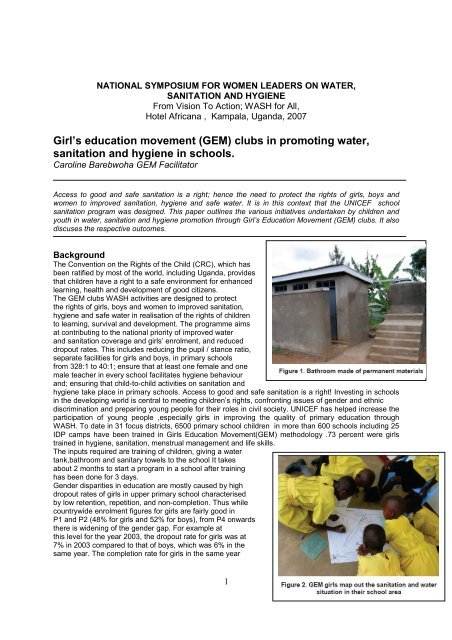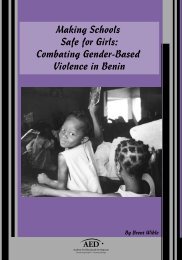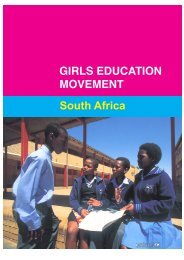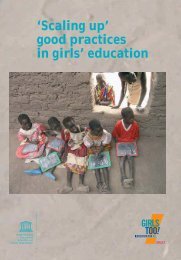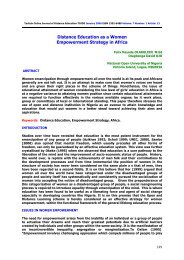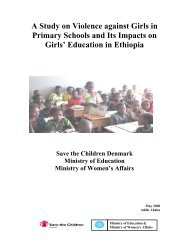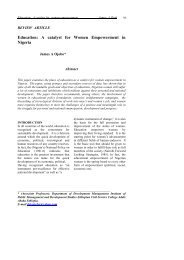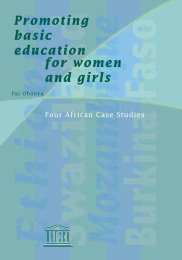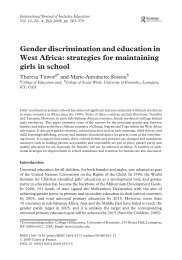Girl's education movement (GEM) clubs in promoting water ...
Girl's education movement (GEM) clubs in promoting water ...
Girl's education movement (GEM) clubs in promoting water ...
Create successful ePaper yourself
Turn your PDF publications into a flip-book with our unique Google optimized e-Paper software.
NATIONAL SYMPOSIUM FOR WOMEN LEADERS ON WATER,<br />
SANITATION AND HYGIENE<br />
From Vision To Action; WASH for All,<br />
Hotel Africana , Kampala, Uganda, 2007<br />
Girl’s <strong>education</strong> <strong>movement</strong> (<strong>GEM</strong>) <strong>clubs</strong> <strong>in</strong> promot<strong>in</strong>g <strong>water</strong>,<br />
sanitation and hygiene <strong>in</strong> schools.<br />
Carol<strong>in</strong>e Barebwoha <strong>GEM</strong> Facilitator<br />
Access to good and safe sanitation is a right; hence the need to protect the rights of girls, boys and<br />
women to improved sanitation, hygiene and safe <strong>water</strong>. It is <strong>in</strong> this context that the UNICEF school<br />
sanitation program was designed. This paper outl<strong>in</strong>es the various <strong>in</strong>itiatives undertaken by children and<br />
youth <strong>in</strong> <strong>water</strong>, sanitation and hygiene promotion through Girl’s Education Movement (<strong>GEM</strong>) <strong>clubs</strong>. It also<br />
discuses the respective outcomes.<br />
Background<br />
The Convention on the Rights of the Child (CRC), which has<br />
been ratified by most of the world, <strong>in</strong>clud<strong>in</strong>g Uganda, provides<br />
that children have a right to a safe environment for enhanced<br />
learn<strong>in</strong>g, health and development of good citizens.<br />
The <strong>GEM</strong> <strong>clubs</strong> WASH activities are designed to protect<br />
the rights of girls, boys and women to improved sanitation,<br />
hygiene and safe <strong>water</strong> <strong>in</strong> realisation of the rights of children<br />
to learn<strong>in</strong>g, survival and development. The programme aims<br />
at contribut<strong>in</strong>g to the national priority of improved <strong>water</strong><br />
and sanitation coverage and girls’ enrolment, and reduced<br />
dropout rates. This <strong>in</strong>cludes reduc<strong>in</strong>g the pupil / stance ratio,<br />
separate facilities for girls and boys, <strong>in</strong> primary schools<br />
from 328:1 to 40:1; ensure that at least one female and one<br />
male teacher <strong>in</strong> every school facilitates hygiene behaviour<br />
and; ensur<strong>in</strong>g that child-to-child activities on sanitation and<br />
hygiene take place <strong>in</strong> primary schools. Access to good and safe sanitation is a right! Invest<strong>in</strong>g <strong>in</strong> schools<br />
<strong>in</strong> the develop<strong>in</strong>g world is central to meet<strong>in</strong>g children’s rights, confront<strong>in</strong>g issues of gender and ethnic<br />
discrim<strong>in</strong>ation and prepar<strong>in</strong>g young people for their roles <strong>in</strong> civil society. UNICEF has helped <strong>in</strong>crease the<br />
participation of young people ,especially girls <strong>in</strong> improv<strong>in</strong>g the quality of primary <strong>education</strong> through<br />
WASH. To date <strong>in</strong> 31 focus districts, 6500 primary school children <strong>in</strong> more than 600 schools <strong>in</strong>clud<strong>in</strong>g 25<br />
IDP camps have been tra<strong>in</strong>ed <strong>in</strong> Girls Education Movement(<strong>GEM</strong>) methodology .73 percent were girls<br />
tra<strong>in</strong>ed <strong>in</strong> hygiene, sanitation, menstrual management and life skills.<br />
The <strong>in</strong>puts required are tra<strong>in</strong><strong>in</strong>g of children, giv<strong>in</strong>g a <strong>water</strong><br />
tank,bathroom and sanitary towels to the school It takes<br />
about 2 months to start a program <strong>in</strong> a school after tra<strong>in</strong><strong>in</strong>g<br />
has been done for 3 days.<br />
Gender disparities <strong>in</strong> <strong>education</strong> are mostly caused by high<br />
dropout rates of girls <strong>in</strong> upper primary school characterised<br />
by low retention, repetition, and non-completion. Thus while<br />
countrywide enrolment figures for girls are fairly good <strong>in</strong><br />
P1 and P2 (48% for girls and 52% for boys), from P4 onwards<br />
there is widen<strong>in</strong>g of the gender gap. For example at<br />
this level for the year 2003, the dropout rate for girls was at<br />
7% <strong>in</strong> 2003 compared to that of boys, which was 6% <strong>in</strong> the<br />
same year. The completion rate for girls <strong>in</strong> the same year<br />
1
was 65% while that of boys was 71%.<br />
Unfriendly school environment also serves to discourage girls from persist<strong>in</strong>g <strong>in</strong> school. Many girls drop<br />
out due to <strong>in</strong>adequate sanitation and hygiene facilities to cater for their needs dur<strong>in</strong>g menstruation, few<br />
female teachers, <strong>in</strong>adequate school <strong>in</strong>frastructure such as classrooms and furniture and sexual<br />
harassment by teachers or boys. Girls are also affected by violence, gender discrim<strong>in</strong>ation <strong>in</strong> the<br />
classroom and poor enforcement of policies and laws regard<strong>in</strong>g issues such as corporal punishment,<br />
child labour, school charges/fees and re-entry <strong>in</strong>to school especially when girls have become pregnant. A<br />
study1 showed that approximately n<strong>in</strong>ety-two percent (92%) of schools <strong>in</strong> the sample had six (6) latr<strong>in</strong>e<br />
stances or less and sixty-seven (67%) had no latr<strong>in</strong>e stances exclusively for girls. Management <strong>in</strong> several<br />
schools stressed the lack of latr<strong>in</strong>e stances for girls as a serious concern. It was also observed that<br />
mature girls had no chang<strong>in</strong>g facilities. They would have to move to neighbor<strong>in</strong>g homes to change dur<strong>in</strong>g<br />
their menstruation periods. In addition they found that the children’s worst experiences centered on <strong>water</strong><br />
and latr<strong>in</strong>es particularly for girls. The pupils were also concerned about the few teachers that were<br />
available <strong>in</strong> the schools. Other problems specific to pupils <strong>in</strong>cluded lack of a senior woman teacher for<br />
female pupil guidance.<br />
Figure 1. Bathroom made of permanent materials<br />
1 Carasco, 1996<br />
Methodology<br />
Child Participation is key. Various means of <strong>in</strong>volv<strong>in</strong>g the young people are used. Children need to get<br />
<strong>in</strong>volved <strong>in</strong> the issues that concern them because they are the experts <strong>in</strong> this. Various <strong>clubs</strong> are be<strong>in</strong>g<br />
promoted like school health/sanitation <strong>clubs</strong>, child rights <strong>clubs</strong> and Girl’s Education Movement (<strong>GEM</strong>)<br />
<strong>clubs</strong>.<br />
<strong>GEM</strong> is a child-centered, girl-led global <strong>movement</strong> of children and young people whose goal is to br<strong>in</strong>g<br />
about positive social transformation <strong>in</strong> Africa by empower<strong>in</strong>g girls through <strong>education</strong>. It is a <strong>movement</strong><br />
and operates through groups of children and young people <strong>in</strong> schools and communities with girls tak<strong>in</strong>g<br />
the lead; boys act<strong>in</strong>g as strategic allies while the adults - women and men – provide the wisdom of age. It<br />
is these groups that subsequently make the decision on how to <strong>in</strong>teract with and help one another at<br />
community, district, national, regional and <strong>in</strong>ternational levels <strong>in</strong> co-operation with appropriate<br />
government, civil society and donor organisations. <strong>GEM</strong> was launched <strong>in</strong> August 2001 <strong>in</strong> Kampala by the<br />
President of Uganda, Yoweri Kaguta Museveni and the UNICEF Executive Director Carol Bellamy and<br />
was also <strong>in</strong>troduced at the Smart Partnership Conference. From the start, young people were <strong>in</strong>volved <strong>in</strong><br />
different activities of the <strong>GEM</strong> launch conference. Fifty of these boys and girls from various schools and<br />
<strong>in</strong>stitutions of learn<strong>in</strong>g were equipped with excit<strong>in</strong>g and highly creative facilitation skills that prepared them<br />
to play a lead<strong>in</strong>g role <strong>in</strong> the activities of the launch.<br />
The Girls’ Education Movement (<strong>GEM</strong>) <strong>in</strong> Uganda has become a highly child-centred, girl-led grassroots<br />
<strong>movement</strong> for address<strong>in</strong>g barriers to girls’ <strong>education</strong> <strong>in</strong> Uganda. Girls have characteristically taken the<br />
lead <strong>in</strong> expand<strong>in</strong>g school/community strategies for gett<strong>in</strong>g girls <strong>in</strong>to school and have co-opted boys as<br />
strategic allies.<br />
Peer Guidance and counsel<strong>in</strong>g<br />
With the advent of <strong>GEM</strong>, another important aspect of pupils’ relationships has emerged. This is peer<br />
guidance and counsel<strong>in</strong>g and mentor<strong>in</strong>g. Children, especially those <strong>in</strong> leadership avail themselves to<br />
others for counsell<strong>in</strong>g. Girls who need counsell<strong>in</strong>g about issues like menstruation for example f<strong>in</strong>d a<br />
will<strong>in</strong>g ear <strong>in</strong> their peers. Older children have also taken on the responsibility of mentor<strong>in</strong>g younger<br />
children, help<strong>in</strong>g them cope with situations that would otherwise been hard for them to deal with. The girlchild<br />
has also benefited from these tra<strong>in</strong><strong>in</strong>g programmes. Schools are now sensitive to the special needs<br />
for girls. Children, through their <strong>GEM</strong> <strong>clubs</strong> also discuss how to keep their toilets clean.<br />
<strong>GEM</strong> Income generat<strong>in</strong>g Activities<br />
Children have realized that they need a certa<strong>in</strong> degree of self-reliance and have therefore taken on<br />
grow<strong>in</strong>g of vegetables, which they sell to get money to support their club activities. They also stage drama<br />
2
and music performances for the communities and these too earn them some <strong>in</strong>come. Children<br />
themselves keep records of daily sales. The <strong>GEM</strong> club members, out of the money from their <strong>in</strong>come<br />
generat<strong>in</strong>g activities, buy sanitary pads for manag<strong>in</strong>g menstruation and items like soap.<br />
Music and drama<br />
The music and drama shows have been a very useful tools for mobilisation and sensitisation of the<br />
communities on issues such as girls’ <strong>education</strong> hygiene and HIV/AIDS. The demand for these visits is<br />
high. They also advocate and lobby the school management for the school to provide sanitation materials<br />
like soap and <strong>water</strong>. They acquire all these are the skills from the tra<strong>in</strong><strong>in</strong>g they undergo where they also<br />
ga<strong>in</strong> knowledge on sexuality and reproductive health issues as well common barriers to girl’s <strong>education</strong>.<br />
Development of IEC materials<br />
Various communication and <strong>education</strong> materials have been produced and distributed by the <strong>GEM</strong> <strong>clubs</strong>.<br />
These help re<strong>in</strong>force the verbal messages and are also used as teach<strong>in</strong>g and learn<strong>in</strong>g aides. The ma<strong>in</strong><br />
themes are proper personal hygiene dur<strong>in</strong>g menstruation, hand-wash<strong>in</strong>g, proper use and clean<strong>in</strong>g of<br />
toilets, and girl-child promotion.<br />
Build<strong>in</strong>g bathrooms<br />
Many of the children <strong>in</strong> primary schools <strong>in</strong> Uganda are over age. This means most girls will have started<br />
their menstruation periods while still <strong>in</strong> primary school. In addition, the age of onset of menses has<br />
decreased from 11-13 years to 9-11 years. Washrooms are provided <strong>in</strong> schools for girls to give them an<br />
opportunity to manage menstruation hygienically and with less embarrassment through provision of <strong>water</strong><br />
and privacy. The <strong>GEM</strong> <strong>clubs</strong> participate <strong>in</strong> the construction and ma<strong>in</strong>tenance of their bathrooms.<br />
“We saw the value of girls hav<strong>in</strong>g a bathroom so now we made one out of local materials for boys……<br />
they use it after sports and agriculture activities”, Head teacher Mbarara<br />
The orig<strong>in</strong>al idea was to provide washrooms/chang<strong>in</strong>g rooms for girls, but some schools have appreciated<br />
the concept to the extent that they have provided bathrooms for boys.<br />
“We have a bathroom also. We use it when we have sweated after sports” Boy FGD Mbarara<br />
Outcomes<br />
Improved facilities: As a result of <strong>GEM</strong> <strong>in</strong> action, schools are also <strong>in</strong>creas<strong>in</strong>gly provid<strong>in</strong>g special facilities<br />
for girls such as, separate latr<strong>in</strong>es, bathrooms and sanitary materials and the government recently<br />
allowed schools to use part of the UPE funds for this.<br />
Figure 2. <strong>GEM</strong> girls map out the sanitation and <strong>water</strong> situation <strong>in</strong> their school area<br />
“When the <strong>GEM</strong> club came then we now have sanitary pads for times when they are needed” ( FGD<br />
health prefects Mbarara)<br />
“I have been <strong>in</strong> this school for six years. There was a time I was teach<strong>in</strong>g and a girl had her MP. I told<br />
everyone to leave but her. Then I gave her my jacket to cover herself and told her to go home. There was<br />
no alternative. But now we have a bathroom and emergency sanitary pads” (Teacher Mbarara).<br />
Clean and safe school environment: Attracts children to school and impacts on enrolment. Parents feel<br />
comfortable to send their children to such schools. This can be seen <strong>in</strong> most communities both rural and<br />
urban, where schools with high sanitation standards and cleanl<strong>in</strong>ess have higher enrolment. The <strong>GEM</strong><br />
<strong>clubs</strong> have sanitation and hygiene as one of their key concerns and organise themselves to clean their<br />
toilet’s and compound. They have atta<strong>in</strong>ed a high level of awareness concern<strong>in</strong>g their sanitation and<br />
hygiene. They manage <strong>water</strong> for wash<strong>in</strong>g hands and they say that ever s<strong>in</strong>ce <strong>GEM</strong> was <strong>in</strong>troduced <strong>in</strong><br />
their school, they always have enough soap to wash hands and to use <strong>in</strong> their bathrooms. The bathrooms<br />
are simple, made of local materials, but the children are happy that they have such a vital facility.<br />
Break<strong>in</strong>g the silence: <strong>GEM</strong> members openly discuss issues that were formerly taboo. The silence is be<strong>in</strong>g<br />
broken on issues of menstruation. With the tra<strong>in</strong><strong>in</strong>g the children receive <strong>in</strong> hygiene, sexuality, sexual<br />
3
maturation, guidance and counsell<strong>in</strong>g and HIV/AIDS, they have become more open to discussion issues<br />
and myths. Teachers are also becom<strong>in</strong>g more open.<br />
“The children are now free to talk about menstruation”<br />
(Male Head Teacher)<br />
“We teach them how to make their own sanitary towels”<br />
(Senior Woman Teacher)<br />
Health has improved: The <strong>GEM</strong> <strong>clubs</strong> carry out hygiene <strong>education</strong> through tra<strong>in</strong><strong>in</strong>g they receive from<br />
teachers. There, the girl is taught proper ways of manag<strong>in</strong>g menstruation, good hygiene and they are<br />
expected to pass this <strong>in</strong>formation to their own daughters <strong>in</strong> the future and thus prepare them to<br />
cope better as they grow up and therefore not to drop out of school.<br />
Children are brought <strong>in</strong>to the development process as active<br />
participants and are becom<strong>in</strong>g change agents with<strong>in</strong> their<br />
families and catalysts for community development.<br />
“I learnt how to smoke latr<strong>in</strong>es and wash hands after<br />
us<strong>in</strong>g the latr<strong>in</strong>e at school and so I do it at home now”<br />
(FGD primary pupils Mbarara)<br />
Increased enrolment: Music Dance and Drama seems to<br />
be the most popular <strong>GEM</strong> activity. It also seems to be the<br />
ma<strong>in</strong> <strong>in</strong>centive of children com<strong>in</strong>g back to school. Many<br />
children testify that after see<strong>in</strong>g plays by <strong>GEM</strong> or listen<strong>in</strong>g<br />
to them s<strong>in</strong>g, they are attracted to jo<strong>in</strong> school. A school <strong>in</strong><br />
Mbarara, reported that they have debates on different issues<br />
<strong>in</strong>clud<strong>in</strong>g HIV/AIDS and sanitation. A recent debate was<br />
on “ Sanitation has helped children <strong>in</strong> school to be smarter<br />
than those out of school”.<br />
Recommendations<br />
Girls’ can do it. Given the required support, children and especially girls can work to address issues that<br />
affect them.Boys need to rema<strong>in</strong> as strategic allies and be mobilized to give space to the girls. Support by<br />
school management critical. Where the head teachers and other teachers are available, accommodative<br />
and flexible, <strong>GEM</strong> has had success. Management needs to be conv<strong>in</strong>ced that children can also develop<br />
strategies and produce results to improve their learn<strong>in</strong>g environments.<br />
More partnerships are required <strong>in</strong> <strong>education</strong>. The young are key partners, and need to be <strong>in</strong>volved and<br />
encouraged to participate. There is need to <strong>in</strong>vest more <strong>in</strong> them for capacity build<strong>in</strong>g and susta<strong>in</strong>ability.<br />
Without follow up and supervision implementation can be a problem. Schools that are not monitored tend<br />
to have poorly constructed <strong>in</strong>stallation; weak <strong>GEM</strong> <strong>clubs</strong> and the teachers who were tra<strong>in</strong>ed never<br />
implement what they have learnt <strong>in</strong> workshops.<br />
Behavior change calls for participatory approaches and cont<strong>in</strong>ual re<strong>in</strong>forcement.<br />
More children and teachers need be tra<strong>in</strong>ed and more effective sessions should be <strong>in</strong>troduced to cater for<br />
the student body represented by their leadership. This will ensure susta<strong>in</strong>ability and promote the<br />
children’s participation.<br />
The highest political office <strong>in</strong> Uganda launched <strong>GEM</strong>. Political will is still an important <strong>in</strong>gredient for<br />
success of any grassroots <strong>in</strong>terventions.<br />
Further Work<br />
4
• More support: <strong>GEM</strong> needs to partner with other NGOs and Government so they are not left on their own<br />
s<strong>in</strong>ce some issues are systemic and need large <strong>in</strong>vestments.<br />
• Scale up to rest of country. 25 more districts still rema<strong>in</strong> on the agenda for tra<strong>in</strong><strong>in</strong>g of primary school<br />
children.<br />
• Tra<strong>in</strong> more tra<strong>in</strong>ers. More TOTs will be carried out so those districts are self-sufficient and do not need<br />
to rely on national facilitators.<br />
• Documentation is critical. Comprehensive documentation of <strong>GEM</strong> activities is to cont<strong>in</strong>ue as well<br />
dissem<strong>in</strong>ation of reports.<br />
• Acknowledge and reward efforts: In 2001 Government had put up a reward for schools that had<br />
provisions for girls’ special needs, such as a bathroom, sanitary materials and games uniform for girls.<br />
• Expand partnerships: Other young people partnerships like girl guides and boy scouts need to be<br />
mobilized to promote the <strong>GEM</strong> agenda and hygiene an sanitation issues.<br />
References<br />
1. Carasco J.F, et al factors <strong>in</strong>fluenc<strong>in</strong>g effectiveness <strong>in</strong> primary schools, Makerere<br />
University/UgandaNational Exam<strong>in</strong>ations board, 1996<br />
2. GoU-UNICEF Basel<strong>in</strong>e Survey, 2001<br />
3. UNICEF-GOU mid-term review <strong>education</strong> sector report 11/11/2003<br />
4. UNICEF 2005 Annual Report<br />
5. Gender Parity 2003 Prof. Kwesiga et al.<br />
6. MTR-The School Sanitation Study 2003 Kamuli and Musaazi<br />
7. MTR studies, 2005 Gender Parity (2003 Prof. Kwesiga et al.)<br />
8. Education sector and strategic plan 2004-2015( June 2004)<br />
9. <strong>GEM</strong> Consolidated Report 2004<br />
Note/s<br />
I would like to acknowledge the follow<strong>in</strong>g:<br />
1. Netwas-U and M<strong>in</strong>istry of Education and Sports.<br />
2. District Education Officers, pupils, and teachers of Mbarara District:<br />
o Rub<strong>in</strong>di Boys’ Primary school<br />
o Rub<strong>in</strong>di Girls’ primary school<br />
o Rwenstunga Primary School<br />
o Kikagate Primary school<br />
3. District Education Officers, pupils, and teachers of Masaka District<br />
o Ggulama primary<br />
o Nakatete Primary school<br />
o Rub<strong>in</strong>di Boys Primary school<br />
Contact addresses<br />
Author: Carol<strong>in</strong>e Barebwoha<br />
<strong>GEM</strong> facilitator<br />
C/O Agency For Rights Estates and Property(AFREP)<br />
P.O. Box 426 Kabale<br />
Email: carolbarebo@yahoo.com<br />
Tel: 0782187481<br />
Figure 3. <strong>GEM</strong> Chairperson gives her report<br />
5


